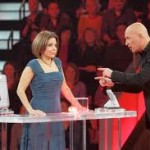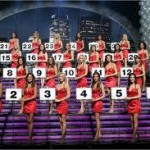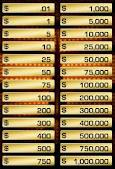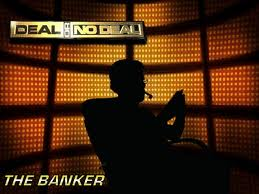The game show “Deal or No Deal” premiered in 2005, and NBC took advantage of its faddish popularity by airing it at least twice a week in primetime. By 2008, it died of overexposure, joining Who Wants to Be a Millionaire and other burn out cases on the obscure Game Show Network. In its heyday, viewers responded to the voyeuristic pleasures of watching frenetic contestants make the biggest financial decisions of their  lives on national TV in front of a cheering audience and the leering Howie Mandel, the show’s skinhead host. But it turns out that there was another niche audience that was rapt in front of the TV – behavioral economists who considered this a unique real life experiment in how people assess financial risk.
lives on national TV in front of a cheering audience and the leering Howie Mandel, the show’s skinhead host. But it turns out that there was another niche audience that was rapt in front of the TV – behavioral economists who considered this a unique real life experiment in how people assess financial risk.
Economists have investigated economic decision-making by creating hypothetical situations. One of the most famous was Daniel Ellsberg, of Pentagon Papers fame, who used urns with different known and unknown proportions of colored balls to determine asked people to make wagers on urns with known and unknown proportions of colored balls. He reported that most people preferred to take the sure thing with a known reward rather than an uncertain outcome with a potentially higher reward. But due to tight research budgets, the payout for these types of experiments was only about $10, not much of a risk even for cash strapped students who were the typical guinea pigs.
Deal or No Deal seemed to be the perfect Plan B, since unlike other game shows, this involved risking large amounts of money PLUS the game required no skill whatsoever – no need for a storehouse of useless trivia, calling in a lifeline or buying a vowel – all contestants do is pick one case from the 26 offered, each hiding a different amount of money ranging from a penny to one million dollars. This is their case to keep and remains closed. Contestants then randomly open the remaining cases one by one. After several are opened, a shadowy “banker” offers the contestant money to stop playing. The amount of money is based on the probability that the contestant has a large value case in their possession. The contestant must either accept the known offer, or continue playing and accept the uncertainty that the next offer could go either up or down. Howie repeatedly asks the contestant, “Deal or no deal?”
It was this type of unadorned “stop or go” decision that got economists so excited, and one by one they started weighing in on Deal or No Deal as a real life experiment on risk-aversion. I found the premise interesting enough, but clearly I was going to be on my own trying to understand it, due to the economists’ impenetrable jargon, such as:
“We analyze the choices of 399 contestants in the Australian version of the television game show “Deal or No Deal.” As a first pass at the data, we calculate risk-aversion bounds for each contestant, revealing considerable heterogeneity. We then estimate a structural stochastic choice model that captures dynamic decision problems faced by contestants. To address individual heterogeneity, we nest the dynamic problem within the settings of both a random effects and a random coefficients probit model. Our structural model produces plausible estimates of risk aversion … we did not find strong evidence in favour of an endowment effect for lotteries.”
Time for me to spend some quality time watching the show. The show starts with Howie Mandel enthusiastically introducing a bevy of large breasted models who enter carrying suitcases numbered from 1 to 26. They are wearing identical skimpy dresses, made from that clingy staticky material that makes you sweat, and then makes your sweat stink. Howie Mandel then calls a contestant from the audience, who promptly erupts in an excited frenzy. The producers are certainly going for quirky– one contestant was a perky farmer from Ohio who said that she was suffering from menopausal hot flashes and urinary urge incontinence (she crossed her legs at this point). She planned to use the money for a new septic system for her farm. A peppy fiancée said she needed the money to finance her wedding, and a cheerful women from the South twanged that she wanted to get her friend some new lips. The camera swung over to the embarrassed friend standing on the sidelines, and I think that everyone tacitly agreed that new lips were a reasonable request. The poor woman had the thinnest almost imperceptible lips that were calling out for plumping.
that clingy staticky material that makes you sweat, and then makes your sweat stink. Howie Mandel then calls a contestant from the audience, who promptly erupts in an excited frenzy. The producers are certainly going for quirky– one contestant was a perky farmer from Ohio who said that she was suffering from menopausal hot flashes and urinary urge incontinence (she crossed her legs at this point). She planned to use the money for a new septic system for her farm. A peppy fiancée said she needed the money to finance her wedding, and a cheerful women from the South twanged that she wanted to get her friend some new lips. The camera swung over to the embarrassed friend standing on the sidelines, and I think that everyone tacitly agreed that new lips were a reasonable request. The poor woman had the thinnest almost imperceptible lips that were calling out for plumping.
So these are the people that the economists are basing their high falutin’ theories on? No contestant said that they needed to fund their IRA, or needed to diversify their bond portfolio, but I guess the economists realized that sometimes you just have to go with what you have got.
One thing that I did pick up from my reading is the concept of expected value. This is the average amount that contestants could expect to win if they played multiple games to the bitter end and did not accept any buy outs – occasionally contestants will win the top  prize, but mostly they will win a small amount since half the cases contain less than $1,000. Attention all you beginning math students out there. Deal or No Deal is a nice illustration of the difference between the mean (i.e. average) and median (i.e. mid point) of a series of numbers. The average is so much higher than the median due to the very large value cases. In fact even before the game starts, the average of all 26 cases is $131,477, while the median is $875.
prize, but mostly they will win a small amount since half the cases contain less than $1,000. Attention all you beginning math students out there. Deal or No Deal is a nice illustration of the difference between the mean (i.e. average) and median (i.e. mid point) of a series of numbers. The average is so much higher than the median due to the very large value cases. In fact even before the game starts, the average of all 26 cases is $131,477, while the median is $875.
The banker’s first offer comes after the contestant opens six cases and theoretically the offer should be even higher than $131,477 if the contestant happens to pick mostly lower value cases. The purely economic strategy is to accept the banker’s buy out only if the offer approaches the average (expected) value of the remaining cases. Well this might make  sense on paper, but this is a dumb strategy for both contestant and banker. First, if the banker offers anywhere near the high average at the beginning of the game, the contestant might take it, and the game would end with a whimper. From the contestants’ point of view, the expected value represents the average winnings if they could play multiple times – but of course contestants only play once. My advice is that if you get anywhere close to the expected value, take the money and run. If you open one of the few remaining high value cases on the next turn, your offer will drop precipitously.
sense on paper, but this is a dumb strategy for both contestant and banker. First, if the banker offers anywhere near the high average at the beginning of the game, the contestant might take it, and the game would end with a whimper. From the contestants’ point of view, the expected value represents the average winnings if they could play multiple times – but of course contestants only play once. My advice is that if you get anywhere close to the expected value, take the money and run. If you open one of the few remaining high value cases on the next turn, your offer will drop precipitously.
And then of course there are the intangible psychological factors that the economists are trying to unravel in the first place. The games I followed had a typical pattern. The first offer from the bank is ridiculously low to keep the contestant in the game. The offers then slowly rise and get closer (but never reaching) to the expected value as additional cases are opened. If a high value case is opened, say the $750,000 one, the model gives a petulant grimace and the audience moans. The contestants are momentarily crestfallen as they assimilate this devastating economic news. They then switch to a “high water mark” strategy, pressing ahead to recoup their paper losses, cheerfully saying “that’s okay, that’s alright, there are still some high value cases out there.” I don’t think that I ever saw a contestant take the first highest offer – contestants had to lose money first before considering a buy out – sometimes they got back to their high water mark, sometimes they got realistic and settled for less.
The economists probably sighed in frustration when the producers started to tinker with the formula by adding gimmicks. One woman was offered an additional $10,000 if she ate 10 worms, another woman who was afraid of heights was offered $10,000 if she agreed to put on a harness and get hoisted to the ceiling, and a man was offered a bonus if he shaved off his moustache. All were very agreeable. Other gimmicks were simply humiliating. One nice young man was routinely ridiculed because he still lived with his parents. Howie then demeaned his profession as a math teacher by comparing his decisions with that of a trained monkey who was brought onto the set. Another man who owned a sidewalk hotdog cart suffered the humiliation of having hundreds of weinies dumped on his head. And then there was the peppy woman who was planning her wedding. In addition to the banker’s offer, the show offered to fly her to New York to meet with Martha Stewart. She just about collapsed with excitement and looked to her boyfriend for advice. He encouraged her to take the deal saying, “Honey, you can’t put a price on Martha Stewart. How frigging cool is that?” When I first saw this, I thought “How sad, this man is not even married yet and he already has his ‘dice in a vice’ – how could he possibly get that excited Martha Stewart?” And then I thought that maybe he was brilliantly manipulative, encouraging his wife to accept a pretty decent offer from the bank based on a fleeting brush with celebrity.
So after spending quality time with “Deal or No Deal,” I have been thinking about my strategy. First I would need to send in a video of me and my chosen support team. I would pick my friend Tom who has a PhD in economics and was able to teach me probability theory on a restaurant napkin, and then I would pick my sister-in-law Debbie for her psychic/intuitive skills – the audience would love her – and then I would pick my brother Tony, and instruct him to only communicate via song parody. For example, to the tune of Hey Jude, Tony would sing to the banker while strumming the mandolin:
Hey Dude, don’t make her sad, take a bad offer and make it better
Remember to soften up your heart and then you can start
To make it better…better….better….better (then let out an anguished cry)
I would then explain that I was planning to invest my winnings in microfinance in order to study the velocity of money. Tom would explain this concept, since his particular skill is simplifying complex topics. Next I would outline how I would select my cases. Most contestants pick case numbers based on birthdays, number of children, etc, but I think I would base my case selection on odd facts. “Howie, I’ll take case 1 since that is the number of times I have been married, case 22 since that is the number of months that an elephant is pregnant. Howie, now I’ll take case number 3, because that is the average weight of the human brain.” And then if I wanted to be a total brown noser, I could say, “Howie, next I’ll take case number 4 since that is the weight of your brain.”
The missing words in the following poem are anagrams (i.e. share the same letters like post, stop, opts) and the number of asterisks indicates the number of letters. One of the missing words will rhyme with either the previous or following line. Your job is to solve for the missing words based on the above rule and context of the poem. Scroll down for answers. Kudos to anywho who can solve this puzzle without peeking – this one is very challenging.
When players pick the top cases, the expected value will take a battering
And the banker’s offer will be economically **********.
I tell contestants,“Stand tall, ********** your spine and get back in the fray.
Buck up, it’s just house money so don’t let paper losses ruin your day.”
But typically ***** ***** grows and they don’t want to lose what they’ve won.
So most contestants accept a low offer and take the money and run.
*
*
*
*
*
*
*
*
Shattering, straighten, their angst
Follow Liza Blue on:
Share:
